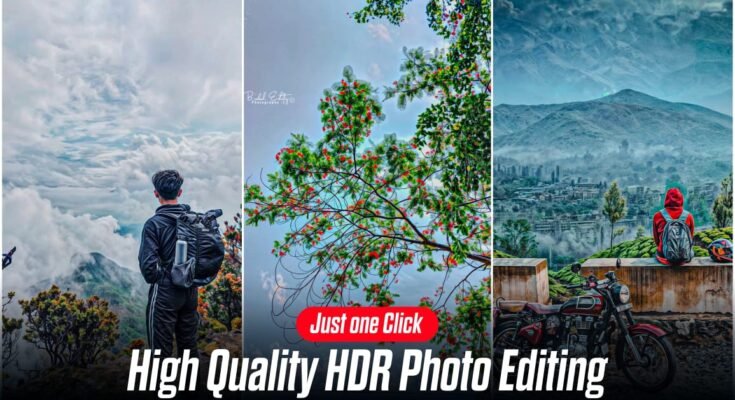The advent of digital photography has continually pushed the boundaries of image quality and editing capabilities. One of the latest innovations in this realm is 8k high-quality HDR (High Dynamic Range) photo editing. This advanced technique merges the incredible resolution of 8k imagery with the superior contrast and color range of HDR, creating photographs that are stunningly detailed and lifelike. As technology continues to evolve, understanding and utilizing 8k high-quality HDR photo editing becomes crucial for photographers and editors who seek to produce the best possible images.
What is 8k High Quality HDR Photo Editing?
8k high-quality HDR photo editing is a sophisticated process that involves manipulating 8k resolution images using HDR techniques. 8k resolution refers to a display or image with a width of approximately 8000 pixels, providing four times the detail of 4k and sixteen times that of full HD (1080p). This high resolution allows for incredibly detailed and sharp images.

HDR, on the other hand, enhances the dynamic range of an image, meaning it captures and displays a broader spectrum of colors and light intensities. HDR images are created by combining multiple photographs taken at different exposure levels, resulting in a final image that better represents the range of light visible to the human eye. When combined, 8k resolution and HDR create images with unparalleled clarity, color depth, and realism.
How 8k High Quality HDR Photo Editing Works
8k high-quality HDR photo editing involves several key steps:
- Capturing the Image: The process begins with capturing the image using an 8k-capable camera. High-resolution sensors ensure that even the smallest details are captured, providing a wealth of information for the editing process.
- Bracketing Exposures: To create an HDR image, multiple shots of the same scene are taken at different exposure levels. This technique, known as bracketing, ensures that both the darkest and brightest areas of the scene are captured in detail.
- Merging Exposures: These multiple exposures are then merged using HDR software. The software combines the best parts of each exposure, resulting in a single image with enhanced dynamic range.
- Editing: The merged HDR image is then edited using advanced software like Adobe Photoshop or Lightroom. This step involves adjusting various parameters such as brightness, contrast, color balance, and sharpness to achieve the desired final look.
- Output: The final image is then exported in an 8k resolution format, ready for display or further use. The high resolution ensures that the image retains its detail and quality even when viewed on large screens or printed in large formats.
Features of 8k High Quality HDR Photo Editing
1. Unmatched Detail and Clarity
8k resolution provides unparalleled detail, making it possible to capture and edit images with incredible sharpness and clarity. This is particularly useful for large prints and professional applications where every detail matters.
2. Enhanced Dynamic Range
HDR techniques allow for a broader range of light and color to be captured and displayed. This results in images that are more true-to-life, with better representation of shadows and highlights.
3. Vivid Colors
The combination of 8k resolution and HDR enhances color depth, making images more vibrant and realistic. This is especially beneficial for landscape and nature photography, where accurate color representation is crucial.
4. Greater Flexibility in Editing
High-resolution images provide more data to work with, giving photographers greater flexibility during the editing process. This allows for more precise adjustments and enhancements, resulting in a superior final product.
5. Improved Print Quality
8k images maintain their quality even when printed in large formats, making them ideal for professional prints, posters, and other large-scale projects.
6. Future-Proofing
As display technology continues to evolve, 8k is becoming the new standard. Editing and producing images in 8k ensures that they remain relevant and of high quality for years to come.
7. Advanced Software Tools
The development of advanced photo editing software has made 8k HDR editing more accessible. Tools like Adobe Photoshop, Lightroom, and specialized HDR software provide a range of features tailored specifically for high-resolution HDR editing.
8. Wide Range of Applications
From professional photography and filmmaking to virtual reality and digital art, the applications of 8k HDR photo editing are vast. This versatility makes it a valuable skill for a wide range of creative professionals.
Pros of 8k High Quality HDR Photo Editing
| Pros | Description |
|---|---|
| Superior Image Quality | Combines high resolution and HDR for unmatched clarity and color. |
| Detailed Editing | Allows for more precise and detailed adjustments. |
| Enhanced Color Depth | Produces vibrant and realistic colors. |
| Better Dynamic Range | Captures a wider range of light and shadow. |
| Professional Output | Ideal for professional prints and large-scale projects. |
| Future-Proof | Keeps images relevant with advancing display technology. |
| Advanced Software | Access to powerful editing tools and features. |
| Versatile Applications | Useful across various creative fields. |
Cons of 8k High Quality HDR Photo Editing
| Cons | Description |
|---|---|
| High Equipment Cost | Requires expensive cameras and editing software. |
| Large File Sizes | Produces very large files, requiring substantial storage. |
| High Processing Power | Demands powerful computers for smooth editing. |
| Learning Curve | Advanced techniques require time and practice to master. |
| Longer Processing Time | Editing and rendering 8k HDR images takes longer. |
| Compatibility Issues | Not all devices and software support 8k resolution. |
| Overwhelming Detail | Excessive detail can be unnecessary for some projects. |
| Bandwidth for Sharing | High-resolution files require more bandwidth for online sharing. |
8k High Quality HDR Photo Editing Alternatives
| Alternative | Description | Pros | Cons |
|---|---|---|---|
| 4k HDR Editing | Lower resolution but still high quality. | Easier to handle, less demanding on hardware. | Less detail compared to 8k. |
| 5k Photo Editing | Intermediate resolution between 4k and 8k. | Better detail than 4k, more manageable than 8k. | Still requires significant resources. |
| Regular HDR Editing | HDR techniques on standard resolutions. | Improved dynamic range without high resolution demands. | Limited detail compared to 8k. |
| RAW Photo Editing | Editing high-quality RAW files. | Retains maximum data for editing flexibility. | Large file sizes, high processing power needed. |
| Panoramic Photo Editing | Creating wide-angle images. | Unique perspectives, immersive experience. | Can be complex to stitch and edit. |
| AI-Powered Editing | Using AI tools for enhancements. | Speed and ease of use, impressive results. | May lack manual control and customization. |
Conclusion and Verdict on 8k High Quality HDR Photo Editing
8k high-quality HDR photo editing represents the pinnacle of current photo editing technology, offering unparalleled detail, dynamic range, and color depth. For professionals and enthusiasts who demand the highest quality in their work, this technique provides a means to achieve extraordinary results. While it comes with challenges such as high equipment costs and demanding processing requirements, the benefits often outweigh these drawbacks for those committed to producing the best possible images. As technology continues to advance, 8k HDR editing is likely to become more accessible, cementing its place as a standard in high-quality photo editing.
FAQs on 8k High Quality HDR Photo Editing
1. What equipment do I need for 8k HDR photo editing?
To engage in 8k HDR photo editing, you need an 8k-capable camera, high-performance computer, advanced editing software (such as Adobe Photoshop or Lightroom), and ample storage solutions for large file sizes.
2. Is 8k HDR editing suitable for beginners?
While beginners can learn 8k HDR editing, it is generally more suited for experienced photographers and editors due to its complexity and the high level of detail involved.
3. What are the main software tools used for 8k HDR photo editing?
Popular software tools include Adobe Photoshop, Adobe Lightroom, and specialized HDR software like Photomatix and Aurora HDR.
4. How do I manage the large file sizes associated with 8k HDR images?
Investing in high-capacity storage solutions, such as external hard drives and cloud storage, is essential. Efficient file management and archiving practices can also help.
5. What are the benefits of using HDR in 8k photo editing?
HDR enhances the dynamic range of your images, capturing more details in shadows and highlights, and producing more vibrant and realistic colors.
6. Can all displays show 8k HDR images correctly?
No, not all displays support 8k resolution or HDR. To fully appreciate the quality of 8k HDR images, you need a compatible 8k HDR monitor or TV.
7. Is it worth upgrading to 8k HDR editing if I already use 4k HDR?
Upgrading to 8k HDR provides a significant boost in detail and color depth. If your work demands the highest possible quality, the upgrade is worthwhile, though it comes with increased costs and hardware demands.
8. How can I learn 8k HDR photo editing?
There are various online courses, tutorials, and workshops available that focus on high-resolution HDR photo editing. Practicing with your own photos and experimenting with different techniques is also valuable.
9. What are the common challenges in 8k HDR photo editing?
Common challenges include managing large file sizes, requiring powerful hardware, mastering complex techniques, and ensuring compatibility with viewing devices.
10. Are there any alternatives to 8k HDR photo editing?
Yes, alternatives include 4k HDR editing, 5k photo editing, regular HDR editing, RAW photo editing, panoramic photo editing, and AI-powered editing. Each offers different benefits and may be more suitable depending on your specific needs and resources.


